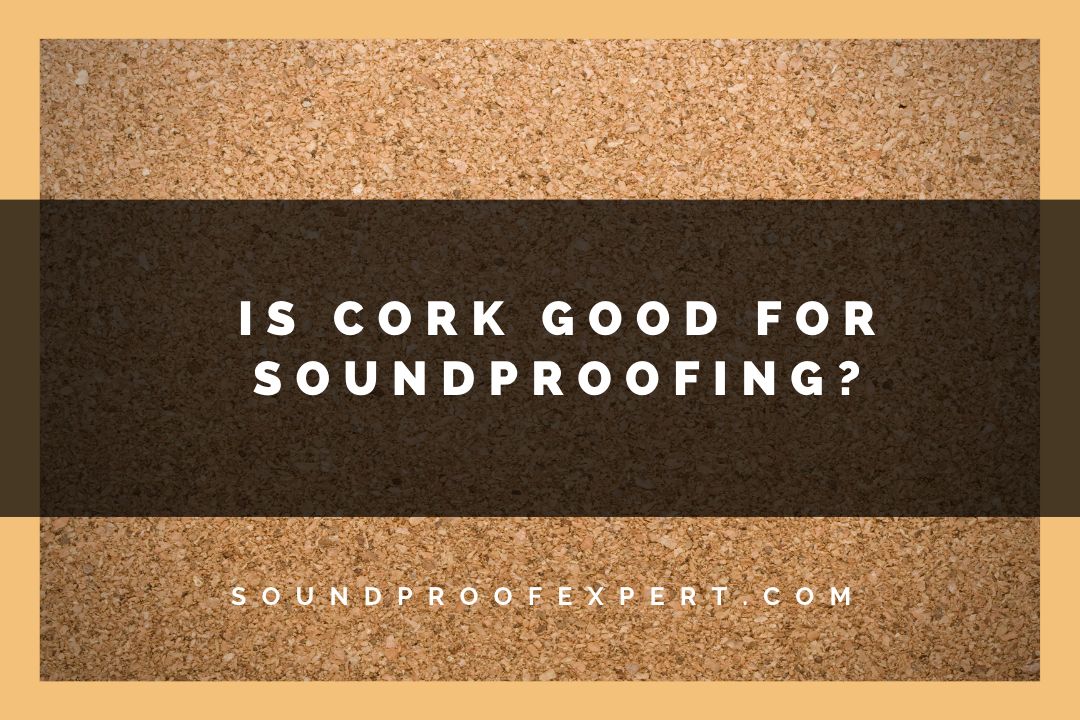
I know what you’re thinking: how can cork be used for soundproofing? Isn’t it just used to stopper bottles of wine?
Cork is good for soundproofing due to its physical properties. Its composition comprises millions of tiny, air-filled cells that act as an acoustic barrier. The cells trap sound waves, so they don’t pass through the material, and excess vibrations are broken down and diffused.
This article will discuss why cork is excellent for soundproofing and how to use it in your home or professional space. I’ll also cover the benefits of using cork for soundproofing, so you can make an informed decision when choosing a material. So read on and learn more about cork!
How Good is Cork for Soundproofing?
Cork is an excellent soundproofing material due to its cellular structure. The Noise Reduction Coefficient (NRC) rating for cork is 0.7, making it one of the most effective soundproofing materials. That means 70% of all sound transmitted through the cork is absorbed while only 30% is reflected.
According to industry standards, materials with an NRC rating of 0.4 and higher are considered effective soundproofing materials. Cork is at the top of the list with its 0.7 ratings, making it one of the best materials for soundproofing.
The cells are filled with air, forming a labyrinth of tiny air pockets that act as tiny soundproofing chambers. The walls between the air pockets help to capture and contain sound waves, preventing them from traveling through the material.
The tensile strength of cork also makes it an attractive option for soundproofing. Its flexibility and compression allow it to absorb sound waves over a wide range of frequencies. This makes it an ideal material for various applications, from recording studios to home theatres.
Does Cork Help With Soundproofing?
Cork does help with soundproofing because it is a versatile material that can be used in various ways to soundproof a space. You can use cork to soundproof the walls, floors, and ceilings. You can also use cork strips to seal windows, cracks, and crevices in your home.
Here’s how you can use cork for soundproofing.
Acoustic Cork Wall Panels
You can attach cork panels to your walls and ceiling to reduce noise transmission from one room to another. Cork panels come in various sizes, colors, and textures, so you can choose the one that best fits your room’s layout and design.
Cork Acoustic Sealing
Cork strips or insulation can seal the cracks and crevices in your space. This will help to prevent sound waves from traveling through these pathways and reduce the noise level in a room. You can also use cork to seal the edges of doors and windows, further improving soundproofing.
Cork Acoustic Flooring
Cork tiles are excellent for soundproofing floors, provided you use the right thickness. The cork will trap any sound that originates on one floor, so you won’t have to worry about hearing footsteps and moving furniture in the room below. Cork tiles also provide thermal insulation, which helps keep your floor warm in winter.
Cork Soundproofing Underlayment
Cork underlayment is often used under carpets and other flooring materials to reduce sound transmission across floors. Like cork tiles, cork underlayment helps to absorb the sounds from footsteps and other activities, significantly reducing noise pollution in a room.
Cork Soundproofing Ceiling Tiles
You can use cork tiles to soundproof your ceiling. They help to reduce the amount of sound that passes through the ceiling and into adjacent spaces. This is especially useful in apartment buildings and other shared living spaces, where noise levels can be a nuisance.
How Thick Does Cork Need To Be for Soundproofing?
Cork must be at least 3mm (0.3 cm) thick to be effective for soundproofing. However, thin layers of cork are not as effective at absorbing sound waves, so you should consider using thicker layers for better soundproofing.
Consider using cork panels that are at least 8mm to 10mm (0.8 cm to 1 cm) thick for optimal soundproofing results. The application will also determine the thickness of the cork needed.
Professional recording studios and other soundproof spaces often use thicker cork panels to achieve superior results.
Installing Cork for Soundproofing
Installing cork for soundproofing is relatively easy. You can use adhesive, nails, screws, or other fasteners to attach the cork to your walls, ceilings, and floors. However, you should always ensure the cork is firmly in place before using it for soundproofing.
Cork must also be adequately sealed to prevent moisture from seeping in and damaging the material. You can use a sealant or contact cement for this purpose.
Advantages of Cork for Soundproofing
Cork is an excellent material for soundproofing because it has a few advantages over other materials.
- Cork is lightweight. The cellular structure of cork means that it is mostly made up of air, making it incredibly lightweight. The lightweight nature of the material means you can easily transport and install it without needing any heavy machinery.
- Cork is durable. Cork is highly resilient to wear and tear, lasting for years with proper care. You won’t have to constantly repair or replace the cork material, saving you time and money in the long run.
- Environmentally friendly. Cork is a renewable resource from cork trees. The material is biodegradable and recyclable, so you won’t damage the environment by soundproofing your home.
- Highly fire retardant. Cork is naturally resistant to fire and does not burn easily. It also has a low smoke generation and is self-extinguishing, which makes it an excellent choice for soundproofing spaces in areas prone to fires.
- Cork is affordable. Cork is relatively inexpensive and easy to install compared to other soundproofing materials. It is also cost-effective and requires minimal upkeep over its lifetime.
- Hypoallergenic. Cork is non-toxic and hypoallergenic, making it a safe option for soundproofing. The material is free of chemicals, so you won’t have to worry about allergies, asthma symptoms, or other health issues.
- Anti-microbial and water resistant. Cork is naturally resistant to moisture and bacteria, making it ideal for soundproofing in damp or high-humidity areas like bathrooms or basements. It also contains suberin, a natural waxy substance that repels insects and rodents, which is a bonus if you’re looking for soundproofing in high-risk areas.
Conclusion
Cork is an excellent soundproofing material, offering superior performance at an affordable price. It is lightweight, durable, environmentally friendly, hypoallergenic, and anti-microbial. It also provides excellent fire retardancy and water resistance.
So if you’re looking for an effective and cost-efficient way to reduce unwanted noise in your home or office, look no further than cork! This versatile material can provide excellent soundproofing results in virtually any environment.

Hello Jim, how are you?
I’m in the process of buying an apartment in a new apartment building that’s still about 6 months away from being finished.
As sound insulation is an absolutely vital factor for us – due to horrible past experiences with noisy neighbours both upstairs and downstairs!!! – and because at this phase of the building’s construction, we are still on time to request for extra high quality insulation against all types of noises like neighbours’ talking/footsteps/children running throughout the house day and night/loud TVs and music/ etc etc, I would like to ask you for your opinion/ know-how : would you recommend we invest in cork panels to be instaled in all walls, ceiling and floors of this apartment in order to turn it into a virtually “neighbour-noise-free” ?
Thank you so much in advance for your reply Jim!
Best Regards,
Maria
Hello Jim.
I thought cork would be a wonderful natural soundproofing, vibration absorption material. Thank you for sharing your voice.
I don’t know if you have experience in the following but my question is to use cork underneath my tower speakers. I have my speakers with their attached plinths on top of a (approximately) 1/8″ ceramic cutting board. I like the look and it raises them a tad more to a desired height. But something is missing: vibration control onto the floor. So I thought why not get another pair of these cutting boards and sandwich a layer or two of cork between them to see how it performs. My question is: How think should the cork be to allow for noticeable sound/vibration control? And what substance should I use to adhere the cork onto the two ceramic cutting boards? Regular paper glue (Elmer’s glue), wood glue, rubber glue, or something stronger?
Thanks